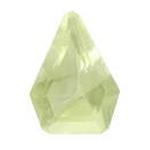|
|
||||||||||||||||
|
||||||||||||||||
|
||||||
|
|
|
|
Shortite
|
|
| | |
| Discovered in 1939; IMA status: Valid (pre-IMA; Grandfathered) | ||
|
| ||
|
Chemistry |
|
|
| |
|
Na2Ca2(CO3)3 | |
|
|
Sodium Calcium Carbonate |
|
Molecular Weight: |
306.16 gm |
|
Composition: |
Sodium |
15.02 % |
Na |
20.24 % |
Na2O |
|
|
Calcium |
26.18 % |
Ca |
36.63 % |
CaO |
|
|
Carbon |
11.77 % |
C |
43.12 % |
CO2 |
|
|
Oxygen |
47.03 % |
O |
|
|
|
|
|
100.00 % |
|
100.00 % |
= TOTAL OXIDE |
|
|
|
||||
|
Classification |
|
|
| |
|
Carbonates | |
|
5/B.05-70 | |
|
|
5 : CARBONATES (NITRATES)
|
|
Related to: |
Eitelite-Shortite-Carbocernaite Series |
|
|
|
|
Crystal Data |
|
|
|
|
|
Crystals are typically wedge-shaped, tabular to short prismatic, to 3 cm, striated. |
|
|
None |
|
|
|
|
|
Physical Properties |
|
|
|
|
|
Distinct on {010} |
|
|
Conchoidal |
|
|
Brittle |
|
|
3.0 - 4.5 |
|
|
2.600 - 2.629 (g/cm3) |
|
|
Pale amber fluorescence under SW UV |
|
|
Not Radioacitve |
|
|
Other: |
Strongly Pyroelectric. Water Soluble; decomposed by water with separation of CaCO3. |
|
|
|
|
Optical Properties |
|
|
|
|
|
Colorless, light Yellow, dark Yellow, light Green |
|
|
Transparent |
|
|
Vitreous |
|
|
1.531 - 1.570 Biaxial ( - ) |
|
|
0.0390 |
|
|
Moderate; r < v |
|
|
X = colorless, Y = colorless, Z = colorless |
|
|
|
|
|
Occurances |
|
|
|
|
|
Geological Setting: |
In saline dolomitic marl (Green River Formation, Wyoming and Utah, USA); in kimberlite dikes (Upper Canada mine, Canada); in carbonatite (Vuoriyarvi massif, Kola Peninsula, Russia); in differentiated alkalic massifs (Kovdor and Khibiny massifs, Kola Peninsula, Russia); associated with an intrusive alkalic gabbro-syenite complex (Mont Saint-Hilaire, Canada). |
|
Common Associations: |
Nahcolite, Pyrite, Trona (Green River Formation, Wyoming and Utah, USA); Apatite, Calcite, Magnetite, Olivine, Perovskite, Phlogopite (Upper Canada mine, Canada); Albite, Barentsite, Natrite, Natrolite, Villiaumite (Khibiny massif, Kola Peninsula, Russia) |
|
Type Locality: |
John Hay Jr. Well No. 1, Green River Formation, Sweetwater County, Wyoming, USA |
|
Year Discovered: |
1939 |
|
View mineral photos: | |
|
|
|
|
Unusual Gem Categories |
|
|
|
|
|
| |
|
|
|
|
More Information |
|
|
|
|
|
| |
|
|
|
|
Shortite was named to honor Dr. Maxwell Naylor Short (1889-1952), Professor of Mineralogy, University of Arizona, Tucson, Arizona, USA. During World War I Short lost both legs in a mine explosion while serving with the 319th Engineers at Camp Fremont, California. This loss handicapped him greatly but did not stop him from doing a great deal of field work and making great contributions to the fields of geology and mineralogy. He was a Fellow of the Mineralogical Society of America and was elected its president in 1939. He was a Fellow of the Geological Society of America and vice-president of that organization in 1940. He was an active member of the American Institute of Mining and Metallurgical Engineers, and the Society of Economic Geologists. He served for many years as one of the associate editors of The American Mineralogist, until the time of his death. Shortite
distribution: n the USA, from the Green River Formation,
Wyoming and Utah, with indicated reserves of billions
of tons; found in the John Hay, Jr. Well No. 1, about
30 km west Green River, Sweetwater County, Wyoming;
and in the Uintah Basin, northeastern Utah. In Canada,
in the Upper Canada gold mine, Kirkland Lake district,
Ontario, and at Mont Saint-Hilaire, Quebec. In Russia,
on the Kola Peninsula, in the Vuoriyarvi carbonatite
complex, from the Kovdor massif, and on Mt. Restin’yun,
Khibiny massif; from the Udachnaya pipe, Daldyn kimberlite
field, Sakha. |
|
|
||||||||||||||||||||||||||||||||||||||||||||||||||||||



